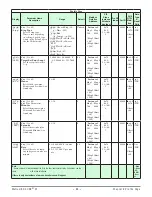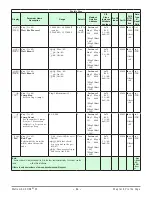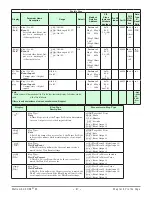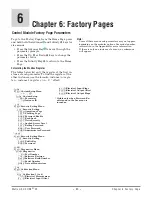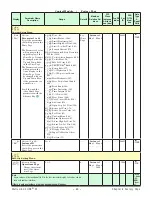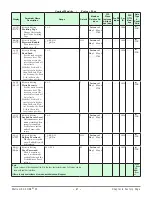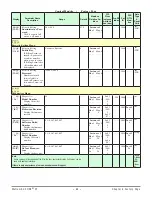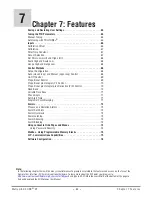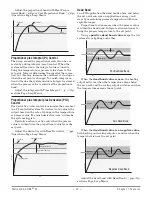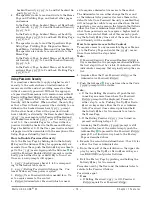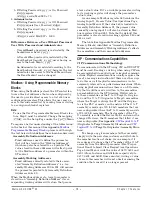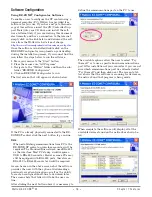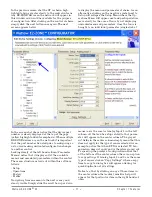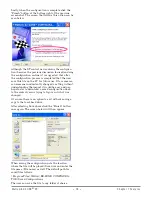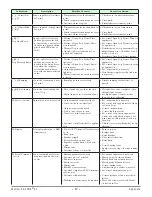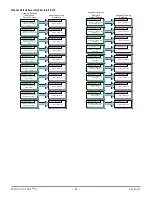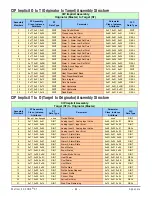
Watlow EZ-ZONE
®
ST
•
69
•
Chapter 7 Features
prior to sensor failure, and that power level is less
than 75 percent.
Time
Temperature
Bumpless Transfer
40%
Sensor
Break
2 minutes
Locks in
Output
Power
0%
Set Point
Actual Temperature
Output Power
Power
100%
Input Error Latching
[`i;Er]
(Setup Page, Analog
Input Menu) determines the controller’s response once
a valid input signal returns to the controller. If latch-
ing is on, then the controller will continue to indicate
an input error until the error is cleared. To clear a
latched alarm, press the Advance Key
‰
then the Up
Key
¿
.
If latching is off, the controller will automatically
clear the input error and return to reading the tem-
perature. If the controller was in the auto mode when
the input error occurred, it will resume closed-loop
control. If the controller was in manual mode when
the error occurred, the controller will remain in open-
loop control.
The Manual Control Indicator Light % is on when
the controller is operating in manual mode.
You can easily switch between modes if the Control
Mode
[`C;M]
parameter is selected to appear in the
Home Page.
To transfer to manual mode from auto mode, press
the Advance Key
‰
until
[`C;M]
appears in the lower
display. The upper display will display
[AUto]
for auto
mode. Use the Up
¿
or Down
¯
keys to select
[Man]
.
The manual set point value will be recalled from the
last manual operation.
To transfer to auto mode from manual mode, press
the Advance Key
‰
until
[`C;M]
appears in the lower
display. The upper display will display
[MAn]
for
manual mode. Use the Up
¿
or Down
¯
keys to select
[AUto]
. The automatic set point value will be recalled
from the last automatic operation.
Changes take effect after three seconds or immedi-
ately upon pressing either the Advance Key
‰
or the
Infinity Key
ˆ
.
On-Off Control
On-off control switches the output either full on or full
off, depending on the input, set point and hysteresis
values. The hysteresis value indicates the amount
the process value must deviate from the set point to
turn on the output. Increasing the value decreases the
number of times the output will cycle. Decreasing hys-
teresis improves controllability. With hysteresis set to
0, the process value would stay closer to the set point,
but the output would switch on and off more frequent-
ly, and may result in the output “chattering.”
On-off control can be selected with Heat Algorithm
[`h;Ag]
or Cool Algorithm
[`C;Ag]
(Setup Page, Loop
Menu).
On-off hysteresis can be set with Heat Hysteresis
[`h;hY]
or Cool Hysteresis
[`C;hY]
(Operations Page,
Loop Menu).
Note:
Input Error Failure Mode
[faIl]
does not function in on-off
control mode . The output goes off .
Set Point
Time
Temperature
The heating action switches off when the process
temperature rises above the set point.
The heating action
switches on at startup.
Hysteresis
Process Temperature
Hysteresis
Time
Temperature
On/Off System Cycles
The cooling action
switches
on at startup.
Process Temperature
The cooling action switches on when
the process temperature rises above
the set point plus the hysteresis.
Set Point
The heating action switches on when the process temperature
drops below the set point minus the hysteresis.
The cooling action switches off when the process
temperature drops below the set point.
Proportional Control
Some processes need to maintain a temperature or
process value closer to the set point than on-off con-
trol can provide. Proportional control provides closer
control by adjusting the output when the temperature
or process value is within a proportional band. When
the value is in the band, the controller adjusts the out-
put based on how close the process value is to the set
point.
The closer the process value is to the set point, the
lower the output power. This is similar to backing off
on the gas pedal of a car as you approach a stop sign.
It keeps the temperature or process value from swing-
ing as widely as it would with simple on-off control.
However, when the system settles down, the tempera-
ture or process value tends to “droop” short of the set
point.
With proportional control the output power level
equals (set point minus process value) divided by the
proportional band value.
In an application with one output assigned to heat-
ing and another assigned to cooling, each will have a
separate proportional parameter. The heating parame-
ter takes effect when the process temperature is lower
than the set point, and the cooling parameter takes ef-
fect when the process temperature is higher than the
set point.

